What will help to benefit with the benefit of joint leisure for children and parents? Experiments, of course. They are not only fascinating entertainment, but are also an additional tool for knowing the world. The following are master classes on experiments for children at home. Children aged three or more years can take an active part in the experiments.
Content
Experiments for children 3 years old
Experience for children: walking rainbow
During this experience, the child can observe the process of absorption of fluid with a solid body.
It will be required:
- plastic transparent glasses with a capacity of 0.5 liters - 7 pieces;
- water;
- liquid food dye;
- spoon/wooden wand for mixing;
- paper towels.
Conducting process:
- Build glasses in a row.
- The first, third, fifth and seventh glasses are filled with water by about 70 percent.
- In the first and seventh glass, add red dye, in the third - yellow, in the fifth - blue. Mix thoroughly.
- Fold the paper towel so that it turns out a long rectangle about 4 cm wide. Make 6 such rectangles.
- Connect nearby glasses with the help of rectangles folded in half.
- After a few hours, the rainbow is ready. During this time, you can observe how the liquid leisurely flows through a paper strip of one glass to another, which colors are obtained when mixing red with yellow or blue, blue with yellow.

Experience for children - citrus bombs
It is recommended to conduct this simple experience with preschool children.
It will be required:
- food soda - 9 tablespoons;
- citric acid - 5 tablespoons;
- vanilla/vanillin;
- starch - 3 tablespoons;
- citrus essential oil - a couple of drops;
- olive oil - 2 tablespoons;
- liquid food dye - a few drops;
- bowl;
- silicone or plastic molds;
- protective gloves.
Production process:
- Place the ingredients in the bowl, thoroughly knead with your hands.
- Lay out the mass through the molds or form classic spherical bombs.
- After 20 hours (10 of which the bombs dry in the forms), the products are ready for use for its intended purpose.

Experiments for children 4 years old
Experience for children - elastic foam
It will be required:
- hot water;
- gelatin;
- dishes;
- liquid food dye;
- corolla;
- the bowl, the number of dishes is determined by the planned number of foam colors;
- protective gloves.
Conducting process:
- Pour water into the bowl, add gelatin, mix thoroughly the mass with a whisk.
- Add detergent and dye, beat the mass with a whisk until lush and elastic foam is formed.
- Guided by the same algorithm to make foam other colors.
- Put the foam in a wide container so that the colors do not mix with each other. Antistress toy is ready.
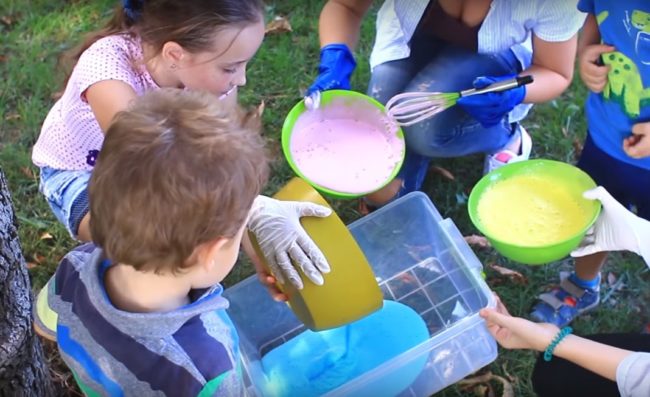
Experience for children - a water cycle in a package
This experience with water for children clearly shows the principle of the cycle of water in nature.
It will be required:
- a transparent package with a reusable fastener;
- water;
- blue food dye;
- scotch.
Conducting process:
- Tint a little water with a dye.
- Pour water into the bag and seal it tightly.
- Using tape, attach a bag of water to the window.
- The result of the experiment will make itself felt after a while. The water in the package will evaporate, rise, cool and fall out in the form of precipitation.
Experiments for children 5 years old
Experience for children - Nonnyutonovsky liquid
You will need:
- water;
- starch;
- liquid food dye;
- bowl;
- spoon;
- protective gloves.
Production process:
- Mix one part of tinted water with one part of the starch.
- After thorough mixing, the Nysusutonovsky fluid is ready. In a calm state, it will show the properties of fluid, and with a sharp physical effect, it will behave like a solid body.

Experience for children - invisible ink
An interesting experience for children will be the creation of spy invisible ink.
You will need:
- lemon juice. Can be replaced with orange or onion juice, vinegar, honey;
- paper;
- cotton wool;
- iron/burning candle/burning incandescent lamp.
Conducting process:
- A cotton wand write a secret message on paper.
- To manifest the inscription you need a heat source. It is most convenient to use an iron. The youngest experimenters are best limited to using incandescent lamp. After heat treatment of paper due to the oxidation reaction, the written one will acquire a brown color.
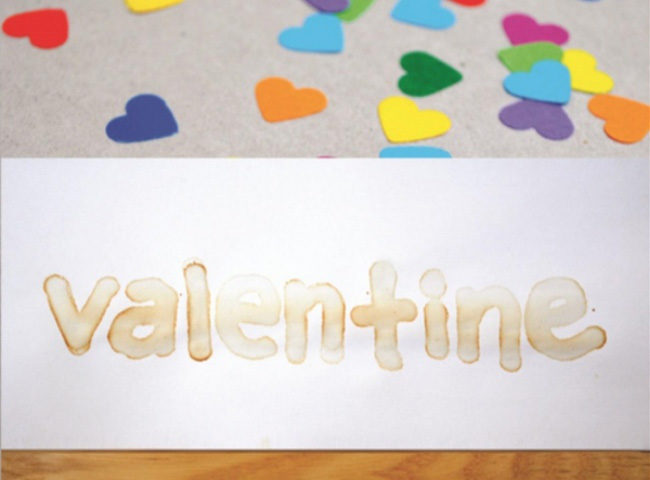
Experiments for children 6 years old
Experience for children - tornado at the bank
You can observe centrifugal power in action on the example of this simple experience for children.
It will be required:
- transparent glass jar of elongated shape with a lid;
- water;
- dishes;
- sparkles.
Conducting process:
- Fill the jar with water by 75 percent.
- Pour a few drops of detergent into the jar.
- Add sparkles and dye.
- Close the jar, spin in a spiral. As a result, the movement of the liquid in the bank will be virtually.
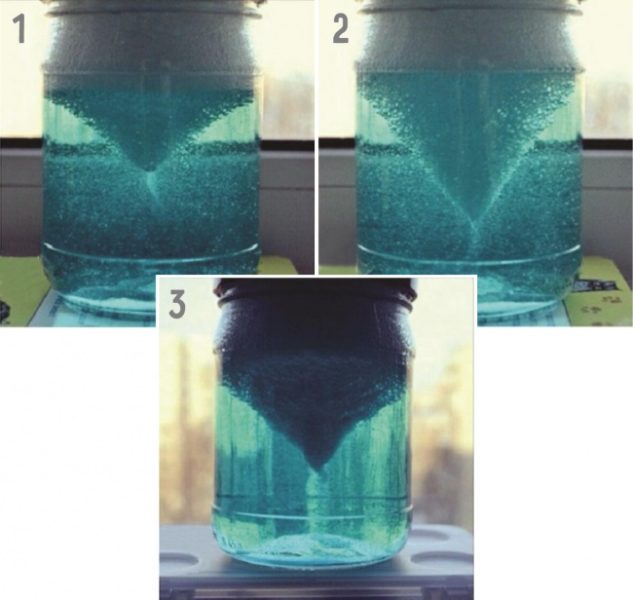
Experience for children - salt crystals
With a little help from relatives, this experience can be carried out since the age of six.
It will be required:
- sodium salt;
- water at room temperature and temperature 50-60 degrees;
- containers of different sizes - 3 pieces;
- spoon.
The above components can be replaced with a special set for experiments for children.
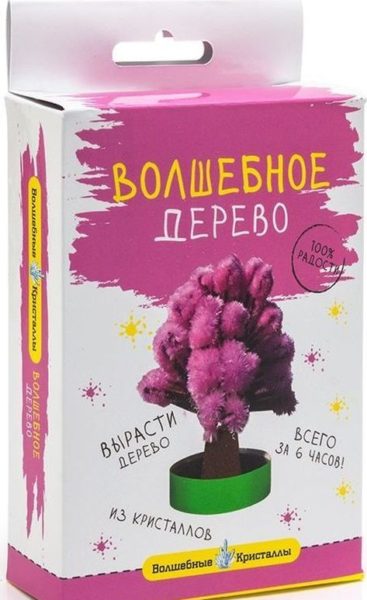
Conducting process:
- Pour heated water into a large container.
- Place a smaller capacity in the larger bowl in which water temperature water is located.
- Pour salt into a smaller container, mix thoroughly, leave for 5 minutes until the crystals dissolve.
- Repeat the actions from the third point until the salt stops dissolving in saline - the resulting liquid will be called a rich solution of salt.
- Fill another bowl with saturated salt solution. It is important that not dissolved crystals of table salt do not fall into a new container.
- At the bottom of the bowl with saturated saline solution, put a large crystal of salt. A few days later, the start of the growth of salt crystal will be noticeable.
- When using special sets, the manufacture of crystals is carried out according to the instructions.
Experiments for children 7 years old
Experience for children - an egg in a bottle
It will be required:
- boiled boiled chicken egg;
- glass bottle with a wide throat;
- paper;
- matches/lighter.
Conducting process:
- Place a small lit sheet of paper in a bottle.
- Put the peeled egg on the neck of the bottle with a sharp end down. The egg will block the access of the oxygen necessary to ensure the combustion process. The flame will go out, the cooling air will begin to contract and the egg will suck into the bottle.
Experience for children - carbon dioxide suppository
This scientific experience for children is designed to demonstrate the effect of carbon dioxide on the combustion process.
It will be required:
- glass bowl;
- baking soda;
- vinegar;
- floating candle;
- matches/lighter.
Conducting process:
- On the side of the bowl, put a lit candle.
- Pour soda into the bowl, extinguish it with vinegar. As a result of the reaction, carbon dioxide will accumulate into the container.
- The upper edge of the bowl is carefully tilt towards the candle. Carbon dioxide does not support combustion and extinguishes the flame.
Experience for children - renewal of combustion
Experience demonstrates the importance of oxygen for the combustion process.
It will be required:
- cup;
- hydrogen peroxide;
- potassium permanganate;
- wooden barbecue skewer/dry branch;
- matches/lighter.
Conducting process:
- Pour hydrogen peroxide into a glass.
- Pour a little potassium permanganate into the liquid. A violent reaction will begin, accompanied by the release of oxygen.
- Dip in a glass a smacking stick so that it does not plunge into the liquid. Due to the large concentration of oxygen, the flame will flare up with great force.
Experience for children - volcanoes
The volcanoes described below can erupt the abundant number of “lava”, so it is recommended to conduct experience either in the bathroom or on the street, or additionally use a large basin.
Volcano in a flask
It will be required:
- dishes;
- hydrogen peroxide 30%;
- liquid food dyes;
- dry yeast/ iodide potassium;
- flask;
- protective gloves.
Conducting process:
- Mix the detergent with peroxide.
- Add a couple of drops of dyes.
- Pour dry yeast or a bottle of potassium iodide.
- Shake the mixture in the flask. The volcano is ready.
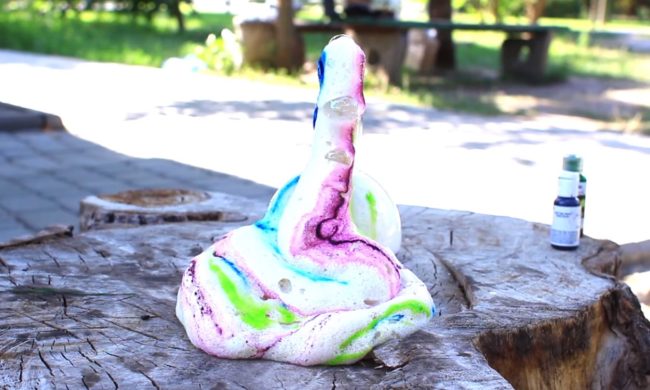
Mini-vulcans
It will be required:
- plastic cups with a capacity of 0.2 liters;
- baking soda;
- food dyes;
- vinegar;
- spoon/wand for stirring;
- protective gloves.
Conducting process:
- Pour 2 teaspoons of soda into glasses.
- Add a little dye to the soda, thoroughly mix the resulting mixture.
- Place the cups in a bath or pelvis.
- Pour vinegar into every glass. The mini-wolves are ready.
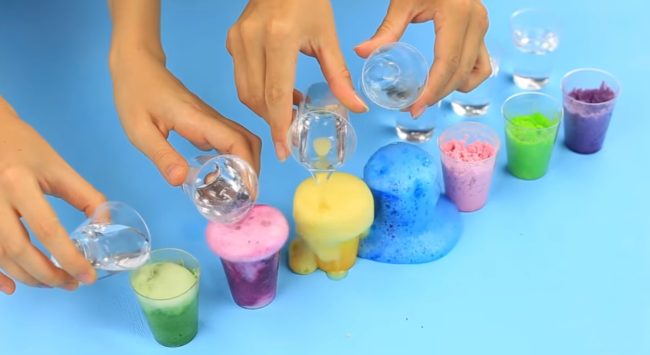
Multi -colored volcano
It will be required:
- water;
- baking soda;
- liquid food dyes;
- small plastic cup;
- spoon/wooden wand;
- vinegar;
- protective gloves.
Conducting process:
- Mix soda with water in such proportions, so that the mass resembles wet sand gets.
- Form from the soda mass of the volcano, arrange it in the form of a recess.
- Decorating the slopes of the volcano with multi -colored dyes.
- Put a mixture of dry soda and red dye in the ventral of the volcano.
- Pour vinegar vulcan into the vent. As a result, the volcano will begin to erupt red lava out of itself.
For clarity, the process of performing experiments for children in a video class class is attached.
Adult experiments for children
Children like these experiments, but unsafe substances are used during the experiments. Recommended for older children under the guidance of adults or adults themselves.
Experience for children - bleaching green
It will be required:
- glass glass;
- water;
- a solution of diamond greens;
- hydrogen peroxide;
- alkali (a tool for cleaning pipes/ammonia);
- protective gloves.
Conducting process:
- Pour water into a glass.
- Give the water intense green with green.
- Pour a little hydrogen peroxide into the solution.
- Add the alkali. As a result of a chemical reaction, the solution will be discolored. Knowing the principle of neutralization of diamond green can be useful in everyday life.
Experience for children - colored metamorphoses
Experience demonstrates the influence of the hydrogen indicator of the medium on the color of the liquid.
It will be required:
- freshly squeezed pomegranate juice. Can be replaced with a brewed frame or finely chopped blue cabbage;
- water;
- plastic cups - 6 pieces;
- hydrochloric acid;
- vinegar;
- baking soda;
- ammonia;
- pipe cleaning tool;
- protecting tools: glasses, gloves, robe.
Conducting process:
- Half is filled with glasses with a pale red solution consisting of grenade juice diluted with water.
- Add a little hydrochloric acid to the first glass. The liquid will acquire a rich red color.
- Pour a little vinegar into the second glass. The color of the solution will also become more intense, but in terms of brightness it will be inferior to the first cup.
- Leave the third cup for comparison with untouched.
- Add a little soda to the fourth glass. The contents of the container will acquire a lilac-gray color.
- Pour ammonia into the fifth cup. After that, the liquid will change its color to khaki.
- The contents of the sixth cup, after adding a small amount of solution for cleaning the pipes, will acquire a brown color.
Experience for children - a reaction of a traffic light
Experience demonstrates the reaction of sugar oxidation in an alkaline environment with the formation of manganese dioxide.
It will be required:
- potassium permanganate (potassium permanganate);
- water;
- sugar;
- glasses - 3 pieces;
- pipe cleaning tool;
- spoon/wooden wand;
- protective gloves.
Conducting process:
- Dissolve potassium permanganate in water.
- Bring the water in a separate container to a saturated pink color by pouring part of the potassium permanganate solution.
- In a separate glass in a small amount of water, dissolve half a teaspoon of sugar.
- Pour into the sugar solution alkali.
- Add water-sakhar-base solution to a solution of potassium permanganate and observe the reaction. First, the liquid will turn blue, then it will green, and then it will turn yellow.
Conclusion
Experiments and experiments for children are good in that they perform several functions at once: entertaining and educational.
Chemical experiments for children can be unsafe, so in no case should be neglected by protecting the eyes, skin, clothing. The complexity of the assigned tasks should correspond to the age of the child.









Comments
a couple of years ago, there was no side of metrogils from the same problem, there were no side effects ...
I’m not a fan of peeling at all, it saves from acne of metrogil, it also smoothes it ...
Great article! ...
I take the second course of the Capsules Climafite 911. The tides went very quickly. It became calmer, irritability went away and I sleep well ...
i also noticed - it is worth nervous, everything immediately affects the face. Therefore, I try to avoid conflicts and unpleasant people. Of the creams, I like Miaflow from wrinkles - smoothes not only small wrinkles ...